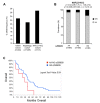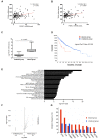The rs599839 A>G Variant Disentangles Cardiovascular Risk and Hepatocellular Carcinoma in NAFLD Patients
- PMID: 33917919
- PMCID: PMC8068289
- DOI: 10.3390/cancers13081783
The rs599839 A>G Variant Disentangles Cardiovascular Risk and Hepatocellular Carcinoma in NAFLD Patients
Abstract
Background and aims: Dyslipidemia and cardiovascular diseases (CVD) are comorbidities of nonalcoholic fatty liver disease (NAFLD), which ranges from steatosis to hepatocellular carcinoma (HCC). The rs599839 A>G variant, in the CELSR2-PSRC1-SORT1 gene cluster, has been associated CVD, but its impact on metabolic traits and on the severity liver damage in NAFLD has not been investigated yet.
Methods: We evaluated the effect of the rs599839 variant in 1426 NAFLD patients (Overall cohort) of whom 131 had HCC (NAFLD-HCC), in 500,000 individuals from the UK Biobank Cohort (UKBBC), and in 366 HCC samples from The Cancer Genome Atlas (TCGA). Hepatic PSRC1, SORT1 and CELSR2 expressions were evaluated by RNAseq (n = 125).
Results: The rs599839 variant was associated with reduced circulating LDL, carotid intima-media thickness, carotid plaques and hypertension (p < 0.05) in NAFLD patients and with protection against dyslipidemia in UKBBC. The minor G allele was associated with higher risk of HCC, independently of fibrosis severity (odds ratio (OR): 5.62; 95% c.i. 1.77-17.84, p = 0.003), poor prognosis and advanced tumor stage (p < 0.05) in the overall cohort. Hepatic PSRC1, SORT1 and CELSR2 expressions were increased in NAFLD patients carrying the rs599839 variant (p < 0.0001). SORT1 mRNA levels negatively correlated with circulating lipids and with those of genes involved in lipoprotein turnover (p < 0.0001). Conversely, PSRC1 expression was positively related to that of genes implicated in cell proliferation (p < 0.0001). In TCGA, PSRC1 over-expression promoted more aggressive HCC development (p < 0.05).
Conclusions: In sum, the rs599839 A>G variant is associated with protection against dyslipidemia and CVD in NAFLD patients, but as one it might promote HCC development by modulating SORT1 and PSRC1 expressions which impact on lipid metabolism and cell proliferation, respectively.
Keywords: HCC; NAFLD; PSRC1; genetic variants; lipid metabolism.
Conflict of interest statement
The authors declare no conflict of interest.
Figures





References
-
- Wong R.J., Aguilar M., Cheung R., Perumpail R.B., Harrison S.A., Younossi Z.M., Ahmed A. Nonalcoholic steatohepatitis is the second leading etiology of liver disease among adults awaiting liver transplantation in the United States. Gastroenterology. 2015;148:547–555. doi: 10.1053/j.gastro.2014.11.039. - DOI - PubMed
Grants and funding
LinkOut - more resources
Full Text Sources
Other Literature Sources

